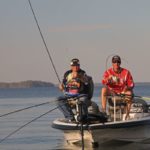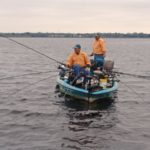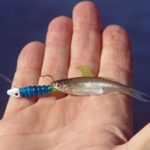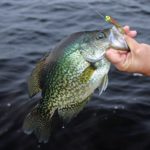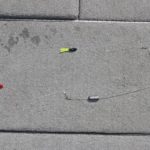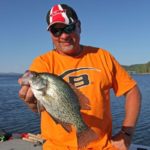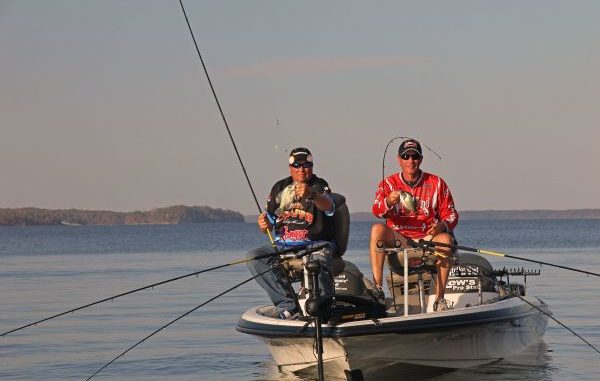
Dragging multiple baits is the best way to up your odds of crappie when the bite gets tough, but there are some tricks to the trade. Here are the thoughts of two experts.
Any chef worth his salt understands the phrase mice en place, which means “everything in its place.”
This wisdom of order and placement also benefits crappie anglers seeking to cook up a hot day of slow trolling action.
We’ll save an in-depth bait analysis for later and focus here on the elements of deployment and presentation. Long-lining off the back of the boat might work in deeper, open-water scenarios, but the closer and more-controlled presentation of slow trolling — aka tight-lining — works best in most Louisiana crappie haunts.
In simplest terms, crappie baits — jigs, minnows or some combination thereof — are trolled at a creeping pace while held vertically by a rigging weight positioned on the main line.
A couple of national crappie tournament pros — Bart Gillon and Wally Marshall, the man known as “Mr. Crappie” — agreed to share some insights into how this tactic can be used to generate bites.
Both anglers believe in slow trolling double rigs — twin baits presented with a three-way swivel or Marshall’s 2-armed Troll-Tech Crappie Rig to maximize bait offerings.
Although a viable tactic just about year-round, Marshall said slow trolling shines during the prespawn and post-spawn, when fish are moving from deeper water and creek channels and into the spawning areas.
“There’s a lot of movement because they haven’t set up to spawn yet,” he said. “You have to cover more water because the crappie are out chasing bait. They’re getting ready to spawn, and they’re trying to load up.
“The fish are scattered and you can find them with trolling rigs.”
A proper spread, Gillon noted, enables the angler to keep all rod tips within his field of vision.
“You want to have it set up to where you have the best opportunity to see every bite you may get,” he said. “In adverse conditions, if everything is not set up perfectly, you may miss some of your bites.”
Colored rod tips help, but it all starts with how you fill those multi-pole racks. Complementing this theme of visual monitoring, Marshall advised anglers to consider where they’re fishing and adjust accordingly.
“The most important thing is getting the widest spread possible for the structure you’re fishing,” he said. “If you’re in open water, you have no issues. But if you’re in tight cover like standing timber, stump fields and you have stuff standing up above the water, you may have to tighten the space between rod tips.
“Maybe you have 4 feet between rod tips, but you may need to tighten them up to where there’s 2 feet between each tip.”
Another helpful adjustment involves angling all the rods forward, especially when working waters around heavy cover and along creek channel edges. Basically, angle the rods on the shore side of the boat forward for a tighter and more-manageable package, while the channel-side rods remain facing outward for a broader spread.
“Angling them forward keeps (the lures) from getting hung up in the shallower water,” Marshall said. “Those fish aren’t up there in 1 to 2 feet of water; they’re over that drop, so when you swing your rack around, you have all of your rods going out the front of the boat and not the side.
“Then, when you turn around and come back the other way, you (reverse your rod positions) so the creek-side rods are always facing out.”
Eight-rod spreads set in two four-rod holders are most common, although industrious types fabricate custom racks accommodating up to a dozen sticks.
But rod length is a critical decision.
Experienced anglers might run a full set of 14- and 16-foot rods for maximum coverage in an open stretch of unobstructed water, but that’s probably not going to work around heavier cover.
Here, Marshall suggested reducing the number of rods and/or switching to shorter models for better control.
Gillon agreed, noting that while experienced crappie anglers like the reach of 16-footers the rods in 12- to 14-foot lengths are best for those unaccustomed to managing such lanky hardware.
Reaching the fish is only part of the challenge; and if you’re unable to effectively boat a fish, the effort is for naught.
“It could be a matter of landing the fish or not, depending on how well you can handle the length of pole you’re fishing with,” Gillon said. “Somebody who’s inexperienced at fishing with this technique will have a difficult time getting their fish in the boat with this technique.”
Gillon likes the Mr. Crappie Custom trolling rods because the soft tip not only allows him to detect light bites, but it also buffers the shock of waves and holds the bait still in the water. Along with this limberness, he also appreciates the rod’s balancing strength.
“With a stiffer rod, the bait will bounce with the boat, but a limber rod will absorb the boat movement,” Gillon said. “Then about three-quarters of that pole is your backbone that’s stout enough to lift those heavier fish.”
With two-person teams, netting your partner’s fish is the way to go. But Gillon said seasoned anglers fishing alone or with a partner can often boat their fish with the help of an edgy technique.
Essentially, you fight the fish topside and then let out a little line to create a pendulum that’s long enough to swing the fish aboard. The deal here is allowing sufficient line off your rod tip so you’re not reaching and grabbing for a flying crappie once you lift that long rod.
“If you have a long pole and a short bit of line, it’s very difficult to swing that fish into the boat,” Gillon warned. “But if you have too much slack, he can shake his head and spit your bait out.
“There is a little art to keeping enough pressure on the fish so you don’t lose him.”
Crappie chasers can go as light as 6-pound line for stealthy presentations in open, clear water. But for structure-laden lakes, Marshall suggested 10-pound mono.
And while clear or camo line might foster peace of mind for the ultra-cautious, Marshall’s a big fan of high-vis yellow.
“When you’re trolling and you’re watching eight rods, a lot of times you won’t see the crappie hit the bait, but you’ll see that line moving to the side,” he said. “A lot of times, they’ll just grab it and sit there with it, and all of the sudden, it just starts moving off. In low-light conditions and (if eyesight is limited), you have to be able to see your line at all times.
“You can see that line twitch at a distance. That’s the key — you have to always stay in contact with your baits.”
However, despite the greater opportunity of double trolling rigs, a single shot might be the wiser choice around thick cover. Here, fewer hooks means fewer chances of snagging.
Not everyone agrees, but Gillon said he’s fine with the percentages.
“A lot of guys say, ‘If you have four poles out, you’re losing four baits,’” he said. “That’s true, but with double rigs I might not be catching fish because I’m hung up. But if you have a single rig, you’re not hung up as much and you’re still fishing.”
Marshall said it’s a matter of carefully watching all lines.
“You’ve got to be on guard at all times for any little movement — any little twitch,” he said. “The guy on the trolling motor has to be under control at all times. If not, he’s going to run all your rods into a brush pile and hang up every one of them.”
Of course, there’s a difference between a bite and being hung up.
“If you see a rod twitch or go down and you know it’s not a fish, you need to back up,” Marshall said. “You need to be where you can hover around that structure. If your lines are backing up, you’re up against something.
“Keep your eyes on your rod, pay attention for any kind of movement or twitch so you can stay under control and stay out of the (cover).”
Speed is the biggest factor, and it’s something beginners often have problems with he said.
“Slow down,” Marshall said. “A lot of people who troll for the first time go too fast. It’s hard to stop a 2,000- or 3,000-pound boat.”
It’s a balance act, he said.
“Make sure that your lines are always taught,” Marshall explained. “Adjust your weight to the speed you want to go and always keep your lines vertical.”
